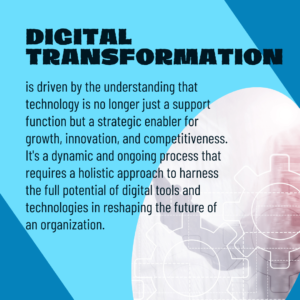The digital landscape rapidly evolves and businesses face unprecedented challenges and opportunities. The key to thriving in this environment lies in successfully navigating digital transformation. One essential framework that plays a crucial role in this journey is ITIL4 (IT Infrastructure Library 4), which has become a cornerstone for organizations seeking to harness the power of digital technologies. In this article, we will explore ITIL4’s role in digital transformation and how it can help your organization thrive in this digital era.
 Understanding Digital Transformation
Understanding Digital Transformation
Before diving into ITIL4’s significance, it’s essential to grasp what digital transformation entails. Digital transformation is not just about adopting new technologies; it’s a strategic approach to leveraging technology, processes, and culture to fundamentally change how businesses operate, deliver value to customers, and gain a competitive edge. It’s about creating a more agile, customer-focused, and efficient organization.
The ITIL4 Framework
ITIL4 is a globally recognized and respected framework for IT service management. It provides a comprehensive set of practices and principles that guide organizations in managing their IT services, from strategy to operations. ITIL4 focuses on delivering value to customers, aligning IT with business objectives, and continually improving service quality.
ITIL4 and Digital Transformation
1. Customer-Centric Approach: ITIL4 places the customer at the center of service delivery. In the digital era, where customer expectations are ever-evolving, this approach is invaluable. It ensures that digital transformation efforts are aligned with customer needs and preferences, driving higher satisfaction and loyalty.
2. Service Strategy: ITIL4’s service strategy emphasizes creating and maintaining a clear and effective service strategy. This is crucial for digital transformation, as it helps organizations define their goals, objectives, and the path forward. It ensures that digital initiatives are purpose-driven, contributing to the overall business strategy.
3. Continuous Improvement: The digital landscape is dynamic. ITIL4’s continuous improvement practices, such as the Plan-Do-Check-Act (PDCA) cycle, help organizations adapt and evolve in response to changing technology and customer demands. This adaptability is vital for digital transformation.
4. Risk Management: Digital transformation often involves risks, including cybersecurity threats, compliance issues, and operational challenges. ITIL4’s risk management practices provide a structured approach to identify, assess, and mitigate risks effectively.
5. Change Management: Successfully implementing digital transformation initiatives requires effective change management. ITIL4 offers guidance on managing changes to IT services and aligning them with organizational goals, making it an essential component of the digital transformation journey.
In the digital era, businesses need to be agile, customer-centric, and adaptive to thrive. ITIL4 serves as a valuable compass for organizations embarking on their digital transformation journey. It helps them align their IT services with business objectives, deliver value to customers, manage risks, and embrace continuous improvement.
To unlock the full potential of ITIL4 and its role in digital transformation, consider taking a certified ITIL4 course and exam through Training Creatively. We offer comprehensive training programs and expert guidance to help you understand and implement ITIL4 in your organization effectively. Take the first step towards a successful digital transformation today.
In conclusion, embracing ITIL4 is not just about managing IT services; it’s about transforming your organization to thrive in the digital age. Don’t miss the opportunity to become proficient in ITIL4 through Training Creatively. Claim your limited offered voucher here and start your journey toward digital transformation success today!
